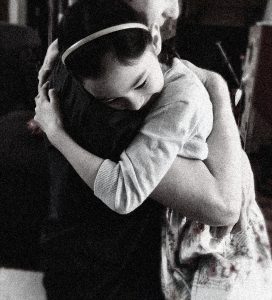Back to School Blues: Why We Need to Hug our Kids More than Ever Before
Whether your kids have just gone back to school or they have been back a few weeks, getting back into the school routine can be challenging for most families. Getting out of bed, getting schoolbooks and homework organised, resuming after school activities and basically finding that rhythm of the new academic year – it’s all pretty exhausting for kids and parents alike. This is especially true this year for obvious reasons. Our kids are going back under difficult circumstances having had their education disrupted for nearly six months. They are also, like us adults, facing an uncertain future with all sorts of measures now in place to stop spreading COVID-19. It is these measures that maybe impacting our children most.
Normalising a World Without Touch
We all understand the importance of putting safeguards in place to stop the spread of the virus. Distancing ourselves, wearing a mask and self-isolating have been measures we have gotten used to if not ‘normalised’ over the past few months. In fact, the adults and kids I have worked with over this period in general are just getting on with living with these restrictions. In a world where just over 6 months ago we would have kissed, hugged, shaken hands just in greeting. Not to mention all the conversations we would have leaned into, and small intimacies like the stroking of an arm or hand to show we are listening, we are there, we understand. Most of what we have learnt about how we communicate friendship, empathy and openness through body language and touch has been lost by our need to distance ourselves and meet more and more in virtual space.
Why ‘Touch Deprivation’ is a Problem
 Touch Deprivation or Starvation is a real phenomenon that has been studied by Psychologists and other health professionals for many years. Starting with studies on the effect of Touch Deprivation in infancy that came out of the experience of babies in orphanages, we have developed a wealth of understanding about what touch means to our physical, mental, emotional and social well-being. Our skin is our largest sense organ. It has been shown that with touch we can not only change the mood of another by raising our levels of oxytocin (the ‘bonding’ hormone) and serotonin (the ‘happy’ hormone) boosting our immune system but we can detect the mood of a person we touch. By even the slightest touch we can convey an emotion, a feeling of trust and acceptance. Touch Deprivation is what we experience when we are not held, stroked, touched by another human being. Lack of touch can cause anxiety or depression by raising levels of stress hormones. This has been a problem in particular for people having to self-isolate for health reasons or ‘at risks’ groups like the elderly during the pandemic.
Touch Deprivation or Starvation is a real phenomenon that has been studied by Psychologists and other health professionals for many years. Starting with studies on the effect of Touch Deprivation in infancy that came out of the experience of babies in orphanages, we have developed a wealth of understanding about what touch means to our physical, mental, emotional and social well-being. Our skin is our largest sense organ. It has been shown that with touch we can not only change the mood of another by raising our levels of oxytocin (the ‘bonding’ hormone) and serotonin (the ‘happy’ hormone) boosting our immune system but we can detect the mood of a person we touch. By even the slightest touch we can convey an emotion, a feeling of trust and acceptance. Touch Deprivation is what we experience when we are not held, stroked, touched by another human being. Lack of touch can cause anxiety or depression by raising levels of stress hormones. This has been a problem in particular for people having to self-isolate for health reasons or ‘at risks’ groups like the elderly during the pandemic.
Are Our Children Suffering from ‘Touch Starvation’?
For many families, especially with younger children, this has been a time of more social interaction in the home. Families have by necessity spent more time together and although this may have led to more conflict it has also in general led to more time for physical contact. For others, the challenge of homeschooling, teleworking from home and lack of organised activities has sent everyone, especially teens, to their respective ‘rooms’ avoiding physical touch. But whether your ratio of family hugs has increased or levelled out during the pandemic, your child is most definitely NOT receiving the same amount of physical touch from the outside world. Is this important in the short term? In truth we do not know. No doubt there will be studies about this in the future but how does that help us and our children now?
How We Can Help our Kids, Ourselves and the People We Love Avoid the Effects of ‘Touch Deprivation’
There is plenty of research around why physical contact is important to us but very little around how to increase our daily quota in a time when it may be difficult to give or receive touch. Here are some general suggestions that could help us all in the coming months.
Find Ways to Increase the Physical Contact at Home
This may seem obvious, but we often don’t think proactively about it. It might help to start by observing how much you actually physically touch members of your family. This will of course vary from families who are generally more ‘touchy-feely’ to those who are not. There is no right or wrong. However, the goal is to increase the amount of physical touch our kids are experiencing at home. Don’t forget your partner too.
Talk About It
This is a shared experience. Unless your kids are not going outside the home they are experiencing a world of people in masks, avoiding each other and a heightened sense of anxiety. If you have older kids you have probably been talking about COVID-19 in general but take the time consciously to talk about Touch Deprivation and its effects on our well-being. It is really important for us to acknowledge and listen to our children’s experience of this especially in their friendship groups. Encourage them to talk to their friends and express how much they miss being able to play closely together without masks. Talking about it can help in your goal to increase physical contact in the home. Teenagers might be more open to us entering their personal space for a hug if they know why we are doing it or maybe not (ha ha!).
Physical Touch Can Come in Many Forms
A simple touch of a hand, shoulder squeeze, foot rub or cuddle are all forms of physical contact we can share everyday. Even sitting closely together and ‘mirroring’ another person’s body language can make us feel more understood. You may want to suggest learning or practicing massage in your family. Teenagers might even be up for the odd session of foot reflexology. There are lots of courses and tutorials online.
 For younger children you might want to set up a hug chart. You could even suggest them showing their affection for members of the family they can’t hug at present e.g. grandparents by acting out with cuddly dolls or animals. Why not include this in a Zoom meeting and let your extended family know how much we want to hug them.
For younger children you might want to set up a hug chart. You could even suggest them showing their affection for members of the family they can’t hug at present e.g. grandparents by acting out with cuddly dolls or animals. Why not include this in a Zoom meeting and let your extended family know how much we want to hug them.
Positive Self-Touch
It’s important to teach our children the importance of positive self-touch. It may sound strange but giving ourselves bear hugs, self-massage and the stimulation of acupressure points can really help when experiencing a lack of physical touch from others. These skills can be talked about with other members of the extended family or friends who are having to self-isolate. They are also good skills to teach younger children to have a positive regard for their body that they can take into the teenage years.
Looking forward positively to a time future when we will not need to keep our distance from each other, maybe we can use this time for some positive talk about what touch means to us all. Because there is no doubt we are all being touched by what we are experiencing, we need to keep talking about it and proactively demonstrating that we are in this together and virtual hugs just won’t do.
Here at Passage, Parent Support Group, we will try to provide face-to-face support when possible. If you know of any parents or professionals who work with families please pass on the details of our meetings which will be updated on our website.
Further Information: Useful Links
Some resources you might find interesting:
The Power of Touch – Jane Anderson Ted Talk
Losing Touch Anther Drawback of the Covid19 Pandemic
Article by: Lynn Frank who is a coordinator for Passage.
Last updated: Thursday 24th September, 2020
